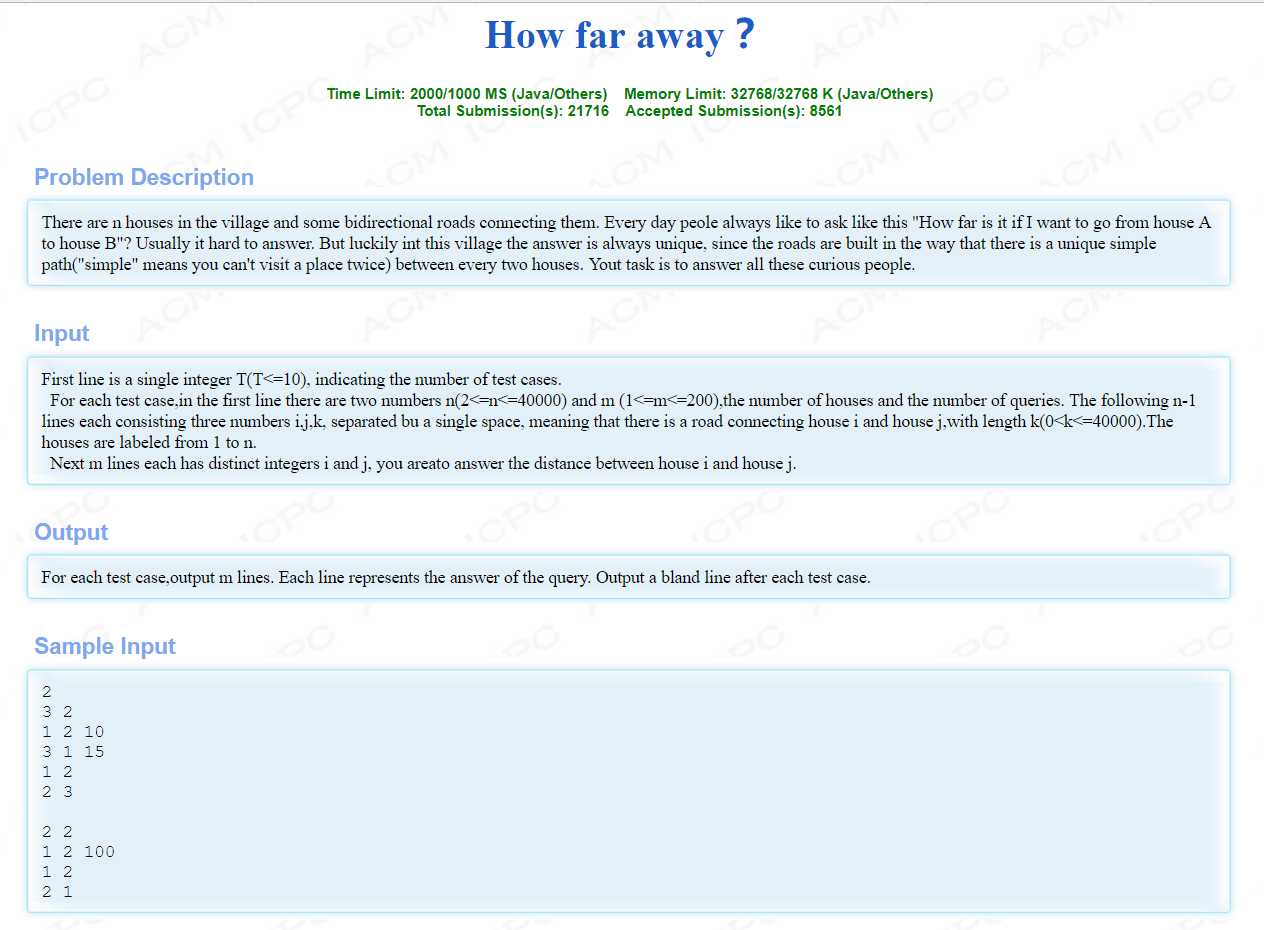LCA的两种求法
Posted q1143316492
tags:
篇首语:本文由小常识网(cha138.com)小编为大家整理,主要介绍了LCA的两种求法相关的知识,希望对你有一定的参考价值。

题意:一棵树,多次询问任意两点的路径长度。
LCA:最近公共祖先Least Common Ancestors。两个节点向根爬,第一个碰在一起的结点。
求出x, y的最近公共祖先lca后,假设dist[x]为x到根的距离,那么x->y的距离为dist[x]+dist[y]-2*dist[lca]
求最近公共祖先解法常见的有两种
1, tarjan+并查集
2,树上倍增
首先是树上倍增。

1 #include <cstdio> 2 #include <cstring> 3 #include <iostream> 4 #include <algorithm> 5 6 using namespace std; 7 const int maxn = 4e4 + 7; 8 9 int T, n, m, u, v, w; 10 11 int first[maxn], sign, st[maxn][21], level[maxn], dist[maxn]; 12 13 struct Node { 14 int to, w, next; 15 } edge[maxn * 2]; 16 17 inline void init() { 18 for(int i = 0; i <= n; i ++ ) { 19 first[i] = -1; 20 } 21 sign = 0; 22 } 23 24 inline void add_edge(int u, int v, int w) { 25 edge[sign].to = v; 26 edge[sign].w = w; 27 edge[sign].next = first[u]; 28 first[u] = sign ++; 29 } 30 31 void dfs(int now, int father) { 32 level[now] = level[father] + 1; 33 st[now][0] = father; 34 for(int i = 1; (1 << i) <= level[now]; i ++ ) { 35 st[now][i] = st[ st[now][i - 1] ][i - 1]; 36 } 37 for(int i = first[now]; ~i; i = edge[i].next) { 38 int to = edge[i].to, w = edge[i].w; 39 if(to == father) { 40 continue; 41 } 42 dist[to] = dist[now] + w; 43 dfs(to, now); 44 } 45 } 46 47 int LCA(int x, int y) { 48 if(level[x] > level[y]) { 49 swap(x, y); 50 } 51 for(int i = 20; i >= 0; i -- ) { 52 if(level[x] + (1 << i) <= level[y]) { 53 y = st[y][i]; 54 } 55 } 56 if(x == y) { 57 return x; 58 } 59 for(int i = 20; i >= 0; i -- ) { 60 if(st[x][i] == st[y][i]) { 61 continue; 62 } else { 63 x = st[x][i], y = st[y][i]; 64 } 65 } 66 return st[x][0]; 67 } 68 69 int main() { 70 scanf("%d", &T); 71 while(T--) { 72 scanf("%d %d", &n, &m); 73 init(); 74 for(int i = 1; i <= n - 1; i ++ ) { 75 scanf("%d %d %d", &u, &v, &w); 76 add_edge(u, v, w); 77 add_edge(v, u, w); 78 } 79 memset(level, 0, sizeof(level)); 80 memset(st, 0, sizeof(st)); 81 dist[1] = 0; 82 dfs(1, 0); 83 for(int i = 1; i <= m; i ++ ) { 84 int u, v; 85 scanf("%d %d", &u, &v); 86 int lca = LCA(u, v); 87 printf("%d ", dist[u] + dist[v] - 2 * dist[lca]); 88 } 89 } 90 91 return 0; 92 }
然后是tarjan的解法(参考算法竞赛进阶指南)
个人理解,tarjan算法就是对搜索的过程中维护了一些性质。在搜索的过程中把点分为三类
1,已经范围且回溯的点,代码中vis[x]=2
2,已经访问还没有回溯的点,代码中vis[x]=1
3,未被标记的点
每一个回溯的点都用并查集连到他的父节点,这样如果我们x点正在访问,我们需要知道x,y的lca,而y已经被访问了,那么并查集y的根就是x,y的lca

1 #include <cstdio> 2 #include <cstring> 3 #include <iostream> 4 #include <algorithm> 5 6 using namespace std; 7 const int MAXN = 5e4 + 7; 8 const int INF = 0x3f3f3f3f; 9 10 int n, m, first[MAXN], sign; 11 12 int pre[MAXN], ans[MAXN], vis[MAXN], dist[MAXN], lca[MAXN], indexs; 13 14 vector<pair<int, int> >query[MAXN]; ///y, id 15 16 struct Node { 17 int to, w, next; 18 } edge[MAXN * 2]; 19 20 inline void init() { 21 for(int i = 0; i <= n; i++ ) { 22 first[i] = -1; 23 pre[i] = i; 24 query[i].clear(); 25 ans[i] = INF; 26 vis[i] = 0; 27 } 28 sign = 0; 29 } 30 31 inline void add_edge(int u, int v, int w) { 32 edge[sign].to = v; 33 edge[sign].w = w; 34 edge[sign].next = first[u]; 35 first[u] = sign++; 36 } 37 38 int findx(int x) { 39 return pre[x] == x ? x : pre[x] = findx(pre[x]); 40 } 41 42 inline void join(int x, int y) { 43 int fx = findx(x), fy = findx(y); 44 pre[fx] = fy; 45 } 46 47 inline bool same(int x, int y) { 48 return findx(x) == findx(y); 49 } 50 51 void tarjan(int now) { 52 vis[now] = 1; 53 for(int i = first[now]; ~i; i = edge[i].next) { 54 int to = edge[i].to; 55 if(!vis[to]) { 56 dist[to] = dist[now] + edge[i].w; 57 tarjan(to); 58 pre[to] = now; 59 } 60 } 61 for(int i = 0; i < query[now].size(); i++ ) { 62 int y = query[now][i].first, id = query[now][i].second; 63 if(vis[y] == 2) { 64 int lca = findx(y); 65 ans[id] = min(ans[id], dist[now] + dist[y] - 2 * dist[lca]); 66 } 67 } 68 vis[now] = 2; 69 } 70 71 int main() 72 { 73 int T; 74 scanf("%d", &T); 75 while(T--) { 76 scanf("%d %d", &n, &m); 77 init(); 78 for(int i = 1; i <= n - 1; i++ ) { 79 int u, v, w; 80 scanf("%d %d %d", &u, &v, &w); 81 add_edge(u, v, w); 82 add_edge(v, u, w); 83 } 84 for(int i = 1; i <= m; i++ ) { 85 int x, y; 86 scanf("%d %d", &x, &y); 87 if(x == y) { 88 ans[i] = 0; 89 continue; 90 } 91 query[x].push_back(make_pair(y, i)); 92 query[y].push_back(make_pair(x, i)); 93 ans[i] = INF; 94 } 95 tarjan(1); 96 for(int i = 1; i <= m; i++ ) { 97 printf("%d ", ans[i]); 98 } 99 } 100 return 0; 101 }
以上是关于LCA的两种求法的主要内容,如果未能解决你的问题,请参考以下文章
